
Jacopo Bellini was one of the founders of the Renaissance style of painting in Venice and northern Italy. His sons Gentile and Giovanni Bellini, and his son-in-law Andrea Mantegna, were also famous painters.
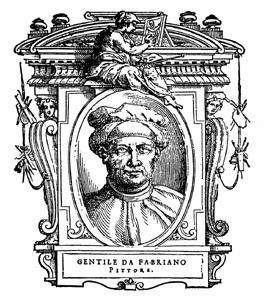
Gentile da Fabriano was an Italian painter known for his participation in the International Gothic painter style. He worked in various places in central Italy, mostly in Tuscany.

Pisanello, born Antonio di Puccio Pisano or Antonio di Puccio da Cereto, also erroneously called Vittore Pisano by Giorgio Vasari, was one of the most distinguished painters of the early Italian Renaissance and Quattrocento. He was acclaimed by poets such as Guarino da Verona and praised by humanists of his time, who compared him to such illustrious names as Cimabue, Phidias and Praxiteles.
The decade of the 1420s in art involved some significant events.

The Madonna of the Quail is an International Gothic painting generally attributed to Pisanello. Dating to c. 1420, it was housed in the Castelvecchio Museum of Verona, northern Italy until stolen in 2015. It would be recovered in 2016.

The St. Peter of Verona Triptych is a tempera-on-panel painting by the Italian early Renaissance master Fra Angelico, executed around 1428–1429. It is housed in the National Museum of San Marco in Florence, Italy.

The Madonna of Humility is a tempera-on-panel painting by the Italian late medieval artist Gentile da Fabriano, dating from around 1420–1423 and housed in the Museo nazionale di San Matteo, Pisa.

The Adoration of the Christ Child is a tempera and gold on panel painting by the Italian late medieval artist Gentile da Fabriano, dating from around 1420–1421 and housed in the Getty Center of Los Angeles, United States.

Ottaviano Nelli (1375–1444?) was an Italian painter of the early Quattrocento. Nelli primarily painted frescoes, but also panel paintings. He had several pupils and two painters were influenced by him.
The Master of Staffolo was an anonymous late-Gothic style painter active in the region of Marche and Umbria.

Saint Francis Receiving the Stigmata is an oil and tempera painting by Gentile da Fabriano, executed c. 1420, now in the Magnani-Rocca Foundation in the Province of Parma in Italy. It is the back of a processional banner - the front showing the Coronation of the Virgin is now in the Getty Center in Los Angeles.
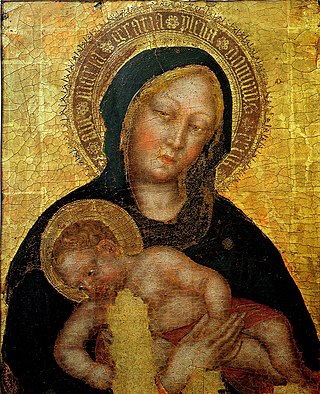
Madonna and Child is a c. 1400-1405 tempera and gold leaf on panel painting by the Italian artist Gentile da Fabriano, now in the Pinacoteca Nazionale di Ferrara. It is signed at the base. Before being restored in 1980 it was thought to be by a follower of the artist due to thick repainting on the whole work.

Madonna and Child is the only surviving fragment of a larger tempera and gold on panel painting by Gentile da Fabriano, executed c. 1423–1425. It is now in the Berenson collection at Villa I Tatti in Settignano. It is dated to the artist's Florentine period due to stylistic similarities with the Madonnas in his Quaratesi Polyptych and Yale Madonna

Madonna and Child is a tempera and gold on panel painting by Gentile da Fabriano, executed c. 1424, now in the Yale University Art Gallery in New Haven. It is signed on the left jamb "Gent / Fabriano". Previously traditionally dated to 1420–1423, the new accepted dating is based on similarities between the background architecture and the north door of the Florence Baptistery, completed by Lorenzo Ghiberti in 1424.

Madonna and Child is a tempera and gold on panel painting by Gentile da Fabriano, executed c. 1420–1423, now in the National Gallery of Art in Washington, D.C. The work is generally identified as one of the first the artist produced in Florence, where he had arrived in summer 1420, at roughly the point at which he was working on the Pala Strozzi. It may have been the central panel of a polyptych, the rest of which is now lost.

Madonna and Child with Two Saints or Madonna and Child in Glory between Saint Francis and Saint Clare is a c.1390–1395 tempera and gold on panel painting by the Italian artist Gentile da Fabriano, now in the Pinacoteca Malaspina in Pavia. It is one of the earliest surviving works attributed to the artist.
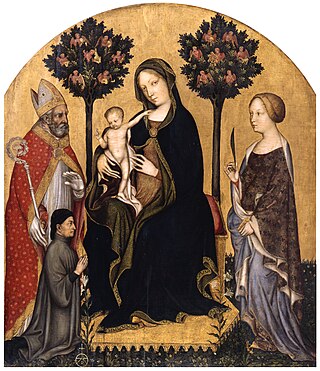
Madonna and Child with Two Saints and a Donor is a c. 1395–1400 tempera and gold leaf on panel painting by the Italian artist Gentile da Fabriano, the earliest surviving major work by the artist. Probably painted for the church of Santa Caterina in Castelvecchio in Fabriano. It is now in the Gemäldegalerie in Berlin.
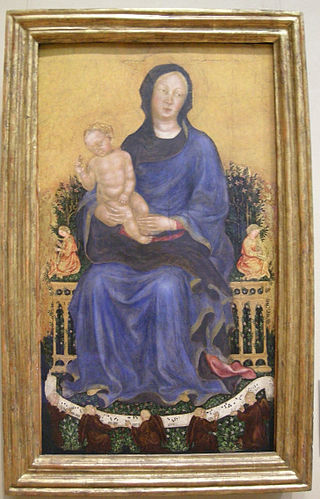
The Davis Madonna is a tempera on panel painting by the Italian artist Gentile da Fabriano, created c. 1410. It is held in the Metropolitan Museum of Art, in New York. The painting is named after Theodore M. Davis who acquired it in Florence, early in the 20th century before leaving it to its present owner in 1915.
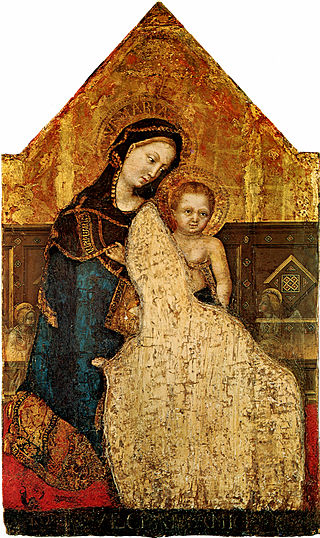
The Velletri Madonna is a tempera and gold on panel painting by Gentile da Fabriano, executed c. 1426-1427, the only surviving work from his stay in Rome. A Madonna of humility, it was in the church of Santi Cosma e Damiano until 1633 when Ludovico Ciotti di San Paolo, General of the Third Order Franciscans, donated it to the Church of Sant'Apollonia in Velletri. It is now in the Diocesan Museum in Velletri. A restoration in 1912 restored the top to its original triangular form.
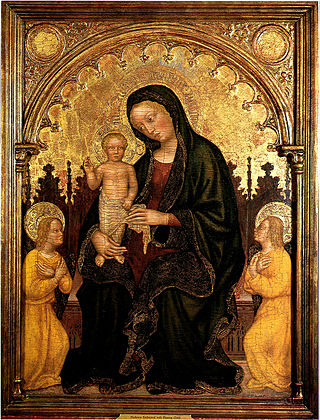
Madonna and Child Enthroned with Two Angels is a c.1410–1415 tempera and gold on panel painting by the Italian late Gothic artist Gentile da Fabriano. Its original provenance is unknown, though its small size probably means it was made for private devotion. It is first recorded in the early 20th century, when it was in the Casa Persicini in Belluno, which suggests it links to the painter's time in Venice. It is now in the Philbrook Art Center in Tulsa, Oklahoma.



















